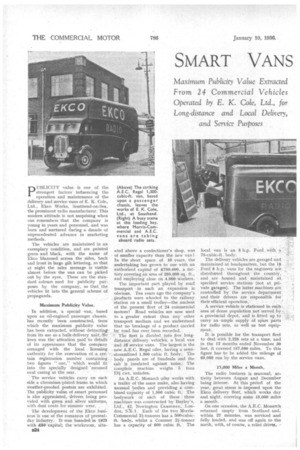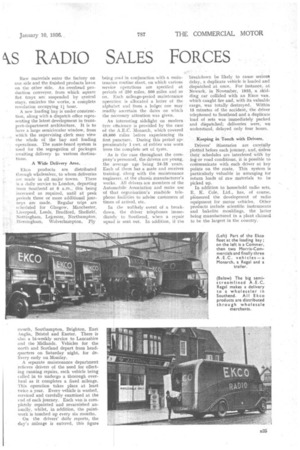SMART VANS
Page 42

Page 43

If you've noticed an error in this article please click here to report it so we can fix it.
kS RADIO SALES FORCES Maximum Publicity Value Extracted From 24 Commercial Vehicles Operated by E. K. Cole, Ltd., for Long-distance and Local Delivery,
and Service Purposes
PUBLICITY value is one of the strongest factors influencing the operation and maintenance of the delivery and service vans of E. K. Cole, Ltd., Ekco Works, Southend-on-Sea, the prominent radio manufacturer. This modern attitude is not surprising when one remembers that the company is young in years and personnel, and was born and nurtured during a decade of unprecedented advance in marketing methods.
The vehicles are maintained in an exemplary condition, and are painted green and black, with the name of Ekco blazoned across the sides, back and front in large gilt lettering, so that at night the sales message is visible almost before the van can be picked out by the eyes. These are the standard colours used for publicity purposes by the company, so that the vehicles fit into the general scheme of propaganda.
Maximum Publicity Value..
In addition, a special van, based upon an oil-engined passenger chassis, has recently been constructed, from which the maximum publicity valise has been extracted, without detracting, from its use as a bulk-delivery unit. ,&) keen was the attention paid to details of its appearance that the company arranged with the local licensing authority for the reservation of a certain registration number containing two figures " one," which would fit into the specially designed recessed
oval casing at the rear. • The service vehicles carry on each side a chromium-plated frame in which weather-proofed posters are exhibited. The publicity value of smart personnel is also appreciated, drivers being provided with green and silver uniforms. with dust coats for summer wear.
The development of the Ekco .business is one of the romances of presentday industry. It was founded in •1925 with •£50 capital; the workroom, situ
s24
ated above a confectioner's shop, was of smaller capacity than the new van! In the short space. of 10 years, the undertaking has grown to one with an authorized capital of £750,000, a factory covering an area of 250,000 sq. ft., and employing close on 4,000 workers.
The important part played by road transport in such an expansion is -obvious. Ten years ago the company's products were wheeled to the railway station on a small 'trolley—the nucleus of the present fleet of ,24 commercial motors! Road vehicles are now used to a greater extent than any other transport medium and we understand that no breakage of a product carried by road has ever, been recorded.
The fleet is divided into five longdistance delivery 'vehicles, a local van and 18 service vans. The largest is the new A.E.C. Regal oiler, having a semi. streamlined 1,300 cubic ft. body. The body panels are of Sundeala and the cab is insulated against noise.The 'Complete machine weighs 5 tons 13-1 cwt. unladen.
An A.E.C. Monarch oiler works with a trailer of the same make, also having unusual bodies and providing a combined capacity of 1,500 cubic ft: The bodywork of each of these three machines was constructed by Bayley's, Ltd.,' 42, Newington Causeway, London, S.E.I. Each of the two MorrisCommercial 24-tonners has a 500-cnbicft. • body, whilst a Commas2i-tonner -has a capacity of 600 cubic ft. The
local van is an 8 h..p. Ford with a 75-cubic-ft. body.
The delivery vehicles are garaged and maintained at headquarters, but the 18 Ford S h.p. vans for the engineers are distribtted throughout the country, and are housed and maintained at specified service stations (not at private garages). The latter machines are controlled by the service department and their drivers are responsible for their efficient operation.
A service vehicle is stationed in each:. area of dense population not served by-: a provincial depot, and is fitted Up to carry an ample supply of spare parts for radio sets, as well as test equipment.
It is possible for the transport fleet to deal with 2,225 sets at a time, and in the 12 months ended November, 30 last, it covered 157,500 miles. To this figure has' tobe added the mileage of 60,000 run by the service vans.
15,000 Miles a Month.
The radio business is seasonal, activity between August and December being intense. At this period of the year, great stress is imposed -upon the Ekco delivery fleet, which works day and night, covering some 15,000 miles a month.
On one occasion, the A.E.C. Monarch. returned empty from Scotland and, within 27 minutes, was serviced and fully loaded, and was off again to. the north, with, of course, a relief driver.
Raw materials enter the factory on one side and the finished products leave on the other side. An overhead production conveyer, from which square fiat trays are suspended by central stays, encircles the works, a complete revolution occupying 11 hour.
A new loading bay is under construction, along with a dispatch office representing the latest development in transport-department architecture. It is to have a large semicircular window, from which the supervising clerk may view the whole of the bay and loading operations. The route-board system is used for the segregation of packages awaiting delivery to various destinations.
A Wide Delivery Area.
Eke° products are distributed through wholesalers, to whom deliveries are made in all major towns. There is a daily service to London, departing from Southend at 6 a.m., this being increased as required, until at peak periods. three or more additional journeys are made. Regular trips are scheduled for Glasgow, Manchester, Liverpool, Leeds, Bradford, Sheffield, s. Nottingham, Leicester, Northampton, ' Birmingham, Wolverhampton, Ply
being read in conjunction with a maintenance routine sheet, on which various service operations are specified at periods of 250 miles, 500 miles and so on. Each mileage-period maintenance operation is allocated a letter of the alphabet and from a ledger one may readily ascertain the dates on which the necessary attention was given.
An interesting sidelight on modern tyre efficiency is provided by the case of the A.E.C. Monarch, which covered 49,600 miles before experiencing its first puncture. During this period approximately 1 cwt. of rubber Was worn from the complete set of tyres.
• As is the case throughout the company's personnel, the drivers are young, the average age being 24-25 years. Each of them has a mate and receives training, along with the maintenance engineers, at the chassis manufacturer's works. All drivers are members of the Automobile Association and make use of that organization's roadside telephone facilities to advise customers of times of arrival, etc.
In the unlikely event of a breakdown, the driver telephones immediately to Southend, when a repair squad is sent out. In addition, if the breakdown be likely to cause serious delay, a duplicate vehicle is loaded and dispatched at once. For inStance, at Newark, in November, 1933, a skidding car collided with an Ekco van, which caught fire and, with its valuable cargo, was totally destroyed. Within 15 minutes of the accident, the driver telephoned to Southend and a duplicate load of sets was immediately packed and dispatched; deliveries were, we understand, delayed only four hours.
Keeping in Touch with Drivers.
• Drivers' itineraries are carefully plotted before each journey, and, unless their schedules are interfered with by fog, or road conditions, it is possible to communicate with each driver at key poiiats on the route. This system is
• particularly valuable in arranging for return loads of raw materials to be picked up.
In addition to household radio sets, E. K. Cole, Ltd., has, of course, pioneered the development of radio equipment for motor vehicles. Other products include scientific instruments and bakelite mouldings, the latter being manufactured in a plant claimed to be the largest in the country.




































































































